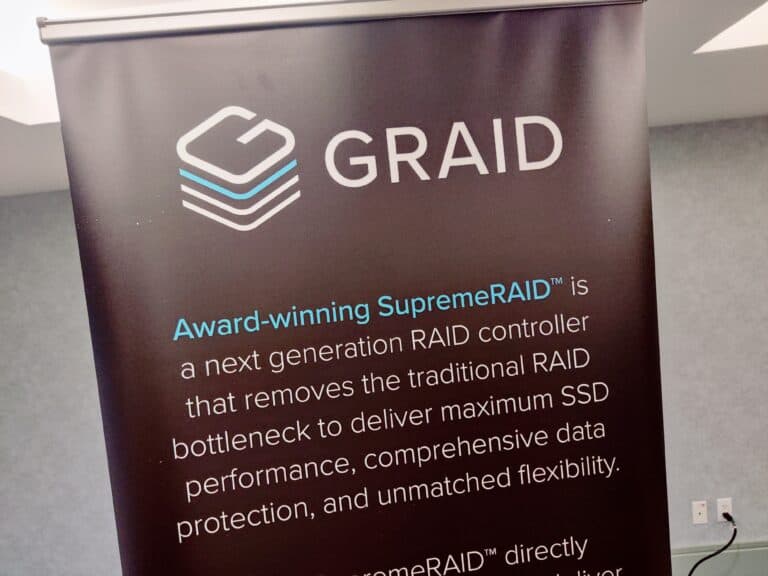GRAID Technology offers a blazingly fast RAID card for enterprise SSDs with a standard workstation NVIDIA video card. By using different software drivers, the NVIDIA GPU is no longer a video card, but a RAID card. GRAID’s products bear the name SupremeRAID. With this, you get a RAID array with NVMe flash storage at your disposal. The performance then also goes up instead of down, as you see with other RAID solutions for SSDs.
GRAID Technology has developed a very attractive RAID solution with an affordable NVIDIA workstation video card. They have simply replaced the drivers so that the GPU is no longer a video card but a RAID controller. The video card chosen must meet a number of requirements. For example, it must fit into a 1u server, be of good quality and offer sufficient performance.


What does GRAID Technology currently offer?
Currently GRAID Technology offers SupremeRAID in two versions, this is a PCIe Gen 3 or 4 video card capable of running SSDs in RAID with extremely high performance. These are the SupremeRAID SR-1000 and the SupremeRAID SR-1010. There are many NVMe SSDs on the market, also for data centers, but running them in RAID is impossible without loss of performance. In fact, this is done mainly software-based through the CPU these days, but your RAID configuration then competes with your application workloads for CPU cycles. Broadcom does offer a hardware solution, but it was originally developed for HDDs and causes performance degradation.
With GRAID Technology, the performance increases. Because the SupremeRAID card has a powerful GPU, it can do this without taxing the CPU. SupremeRAID supports RAID 0, 1, 5, 6 and 10, allowing businesses to choose their preferred RAID mode. In total, there is currently support for 32 drives, but the video cards used are nowhere near their maximum capacity, about half at present. The limit of 32 drives is purely a software limit that can be easily increased.

SupremeRAID supports U.2, M.2, AIC NVMe plug-in cards, as well as SSDs via NVMe over Fabric. The speed of SupremeRAID is well above the speed of traditional raid cards. A RAID card designed for HDDs simply cannot compete with this solution.
Overview
| Name | GRAID Technology |
| Founded | 2020 |
| Industry | Hardware, software, Data center |
| Location | San Francisco Bay Area, Silicon Valley |
| Employees | 11 – 50 |
| Founder(s) | Leander Yu |
| Venture Capital | $17.5 million |
What’s the differentiator?
GRAID Technology turns a normal simple NVIDIA video card into a super-fast RAID controller. Its software drivers and AI algorithms are exceptional. They manage to get the maximum performance out of SSD’s, but also add performance by using multiple SSD’s in one RAID Array. All without taxing the CPU.


Where traditional RAID configurations involve connecting the disks to the RAID card, in this case the NVMe-drives are connected directly to the motherboard. The video card sits in a PCIe interface and controls the entire RAID process from the side. The data goes directly from the SSDs to the applications when reading, but when writing it does go past the SupremeRAID GPU. This is a highly technological development. While not all data goes past the GPU, all commands do go to the GPU, the GPU tells the SSDs where which data should go to.
Where is the focus?
Building out partnerships with major brands. For example, they are in talks with parties like Lenovo and Dell Technologies to make their product also available in solutions from these companies. In addition, Intel is busy with its own GPUs; the intention is for GRAID Technology to port its technology to Intel so that the technology will also be available with Intel GPUs.
There are also talks with AMD, but they only want to do large video cards with much more performance. That could potentially be interesting for HPC in the long run.
Furthermore, PCI Gen5 is coming next year, which requires a new video card and updated drivers to improve performance and maybe even capacity. It is still difficult to predict what this will bring, because while the bandwidth will increase, at this point GRAID Technology is not yet at maximum capacity. When moving from PCI Gen3 to Gen4, it did provide a big performance boost.
What are they doing in Europe?
GRAID Technology SupremeRAID cards are already available in Europe. ARROW is the distributor in Europe and ensures wide availability. Currently, the focus is still on the United Kingdom, France and Germany. The company hopes to sign up partners in more European countries soon.
